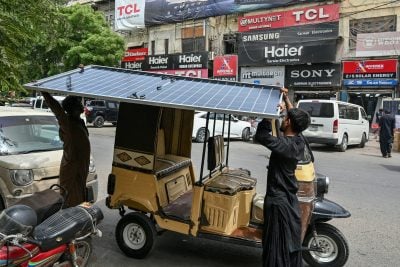Since the land seizures, some farmers have made great strides. But in the absence of government support, many others have faltered.
In 2000, when Reuben H. Greaves was confronted by a group of landless occupiers set on seizing his 52-hectare farm, he asked them if they’d be able to run the battery chicken and wildlife estate his family had managed since World War II.
The future dwellers of the farm – located at Nyamandhlovu in the agricultural heartland of Matebeleland where thousands others were also reallocated land – replied confidently in the affirmative: 15 years later, however, the jury is still out on their success.
On the one hand, Greaves’ former holding has been turned into a cooperative run by locals. Formed in 2002, the Phaphamani Communal Irrigation Scheme specialises in market gardening. Their produce of tomatoes, peppers, kale and carrots is sold to the market in Bulawayo 55km away. Meanwhile, grain is also sold to the government parastatal, the Grain Marketing Board (GMB).
But while providing a livelihood for a number of households, in many other ways the estate stands as a shadow of its former glory.
Lacking capacity and capital, much of Phaphamani’s land is underutilised, and only 13 of the 60 cooperative members actively farm. The pumps and motors of most of the wells have been stolen along with the electric barbed-wire fence that once kept out stray animals and poachers. The seven fowl runs that used to hold 5,000 egg-laying hens each are empty – instead, one shelter provides storage for harvested onions, another houses drying sugar bean pods, and the refrigerated wagons that once held cattle and game carcasses now act as warehouses for maize.
After the land reform
The fate of Phaphamani can be seen as a microcosm of the mixed fate of many resettled farmers across the country, 15 years on from the land seizures in which landless peasants and war veterans claimed land from around 4,000 white-owned commercial farms.
Land reform had been one of the leading ambitions of Zimbabwe’s liberation movement and after independence in 1980, land began to be reallocated, purchased through a ‘willing buyer, willing seller’ scheme funded by the UK.
The pace of this reform, however, was considered far too slow by many Zimbabweans, and when the UK-funded programme was terminated in 1997 as Tony Blair’s Labour Party came to power, frustrations grew.
In 2000, this came to a head as Zimbabweans took it upon themselves to seize land, a move later supported and formalised by government. This popular campaign was sometimes violent and seven white farmers and at least 24 black farm workers died.
But under this ‘fast-track land reform’, nearly 8m hectares was reallocated – compared to just 3.5m from 1980-1999 – and some 160,000 farm households were established. Although some senior government and security officials were awarded multiple farms, research in Zimbabwe’s Land Reform: Myths and Realities by Ian Scoones, Blasio Mavedzenge et al suggests the bulk of resettlers were civil servants, peasants, ex-combatants and townspeople.
Predictably, the act of clearing thousands of productive commercial farmers had devastating effects on the Zimbabwean economy, and many tracts of land today still lie underutilised.
However, at the same time, growing research suggests that many resettled small-scale farmers are now making strides in productivity.
Small farmers have made particular progress in maize and tobacco farming. According to Zimbabwe Takes Back its Land by Joseph Hanlon, Jeanette Manjengwa and Teresa Smart, maize output reached
1,400 Mt in 2014, close to the 1990s average of 1,500 Mt. Small grain harvests meanwhile have grown by 163% compared to the 1990s, and resettled farmers grow 40% of Zimbabwe’s maize and 49% of its tobacco.
Financing the fields
In many parts of the country, however, agriculture is severely struggling, leading even President Mugabe to admit this year that elements of the land reform had been mismanaged.
“I think the farms we gave to people are too large. They can’t manage them,” he told Zimbabwe’s Herald. “You find that most of them are just using one third of the land.”
Hendrik Olivier, Director of the Commercial Farmers’ Union, agrees that farmers are facing difficulties but puts the emphasis on ongoing weaknesses in government policy. “Certainly they are struggling,” he says. “It will take a long time before we see the benefits of land reform because the infrastructure was destroyed and the new farmers don’t have support.”
Indeed, one shortcoming at the heart of many farmers’ struggles has been lack of assistance and financing. Contrary to much popular opinion, there have been impressive developments in terms of clearing land, purchasing equipment and scaling up amongst resettled farmers. And according to Ian Scoones et al, ‘new farmers’ have invested roughly $91m in upgrading their plots.
But there has been very little equivalent support from government.
“State support to the agricultural sector has been completely inadequate,” says Scoones. “Previous successes in Zimbabwean agriculture have been the result of sustained support and investment – whether the white commercial farming of the colonial period or the post-Independence boom in communal area farming.”
Unlike in the pre-2000 or colonial periods, in which commercial farmers’ successes were underpinned by significant government help in the form of loans and implements, most new farmers have simply been left to their own devices.
“When we inherited this land we did not have much to start with….but we’ve tried to start up a few projects,” says Themba Nkomo, chairman of the Phaphamani cooperative. “We don’t get much funding from government and without their support, our potential is really limited, but we’re trying.”
Furthermore, redistributed land is officially owned by the state and many resettled farmers are yet to receive deeds to their farms, meaning they cannot be waged as surety with banks.
Part of the government’s inability to better support Zimbabwe’s farmers has been due to economic instability. Through the 2000s, for example, the economy faced skyrocketing inflation, peaking in 2008 at an absurd 80bn per cent. And more recently, a liquidity crisis led the agriculture budget to be slashed from $390m in 2013/4 to $174m in 2014/5.
Western sanctions have also presented a challenge. Following the land seizures, the US and EU imposed sanctions on Zimbabwean government members. While the measures were targeted at individuals and business entities, the restrictions had broader consequences. Aid programmes continued, but the country’s bad image led to a big drop in tourism and affected Zimbabwe’s ability to access external finance.
In the offices of the Umguza Rural District Council, which oversees the Phaphamani Scheme, sitting opposite a large sign that reads ‘Stop Illegal Sanctions’, council coordinator Titus Moyo insists sanctions have been central in the government’s limited capacity.
“Sanctions, sanctions, sanctions – they are crippling us,” he says. “Farming is a business that requires money, but with the restrictions on Zimbabwe we can’t get funding from the NGOs…We get nothing from the private sector. We have to rely on the little we get from government.”
Shoots of success
Fortunately for Zimbabwe’s farmers, relations between Zimbabwe and the West have begun to thaw, especially since the 2013 elections. Donor aid for resettled farmers has been granted while agricultural trade has grown. Flower sales to the Netherlands have risen, for example, while Belgium is the second-largest importer after China of Zimbabwean tobacco, buying $92.5m worth in 2014.
Meanwhile, the country is also expecting a boost from South-South cooperation. In May, the government signed up for the More Food for Africa programme, a bilateral agreement launched in 2010 by Brazil alongside several African countries. Zimbabwe’s $98m facility is intended to supply small-scale farmers with Brazilian agricultural implements. Hundreds of resettled farmers are expected to participate, including those at Phaphamani.
“We will be able to access farming equipment at a lower price through the programme – this could help us in a big way,” says Moyo. “Our farmers are very poor people and we’ve been unable to secure loans because we’re not commercial farmers, but this scheme will be a trial for something better for us.”
Often starting with very little, Zimbabwe’s resettled farmers have long struggled amidst a lack of financial support, an unstable economic and political environment domestically, and frosty relations internationally.
Common conceptions that Zimbabwe’s seized farms are simply overgrown with weeds, unproductive and uncultivated are far from the truth, as in-depth research has shown. But it is also the case that the vast potential of Zimbabwe’s arable land is a long way off being fulfilled.
Although some of Zimbabwe’s farmers have moved on in the face of unbearable difficulties, many others refuse to give in. Not far from the Phaphamani cooperative, Hleziphe Sibanda, 79, sits outside her hut. She was one of Nyamandhlovu’s early resettlers and has stayed through the hardships. “This land was fought for by blood so I have to stay here,” she says. “I was brought from Bulilimamangwe to stay here and when I came there were trees all around me. The government cleared the land and others came to stay here, but they left their plots. I’ve stayed here a long time since 2000, planting maize and sometimes tomatoes, but this winter it’s been very difficult.”
Seasonal setbacks aside, experts say it takes a generation before the success of a country’s land reform is seen. Fifteen years on from the land seizures and six years on from the worst of Zimbabwe’s political instability, some of Zimbabwe’s farmers have made modest gains despite little government support.
As the domestic and international situation normalises, the next challenge will be to help those green shoots of success truly flourish.
Tendai Marima/James Wan
Want to continue reading? Subscribe today.
You've read all your free articles for this month! Subscribe now to enjoy full access to our content.
Digital Monthly
£8.00 / month
Receive full unlimited access to our articles, opinions, podcasts and more.
Digital Yearly
£70.00 / year
Our best value offer - save £26 and gain access to all of our digital content for an entire year!

 Sign in with Google
Sign in with Google 




